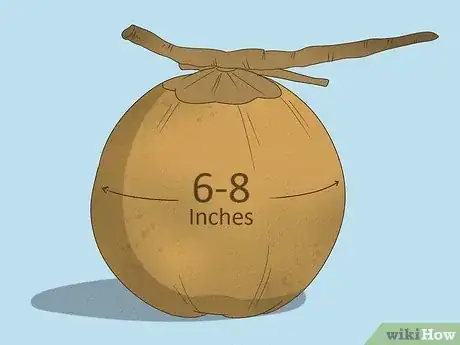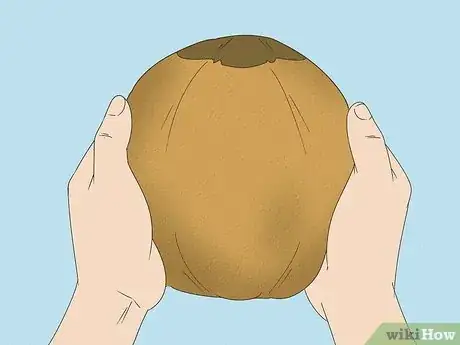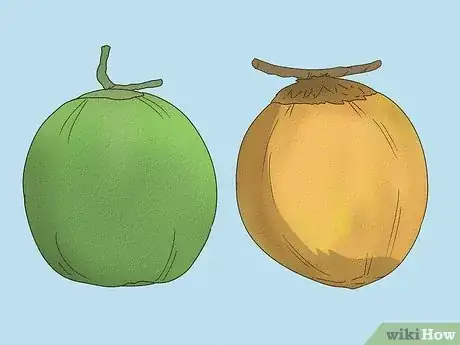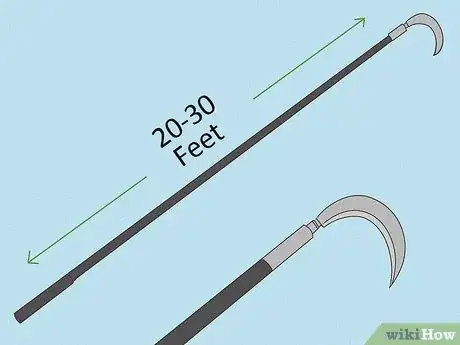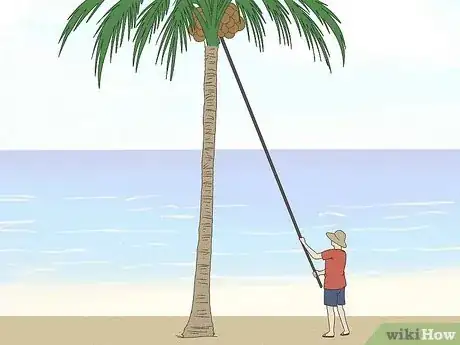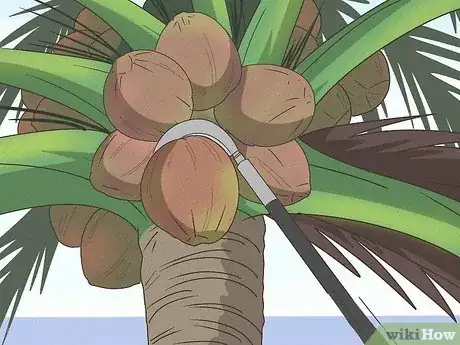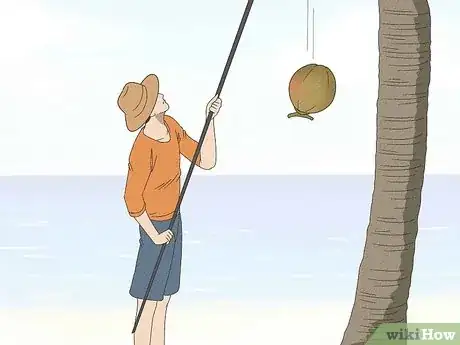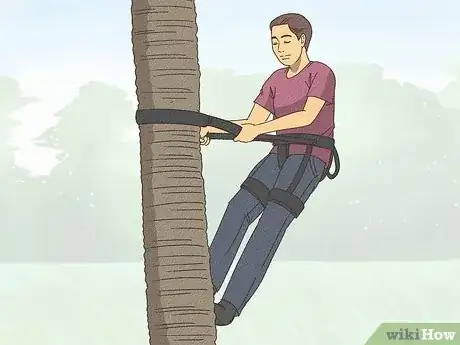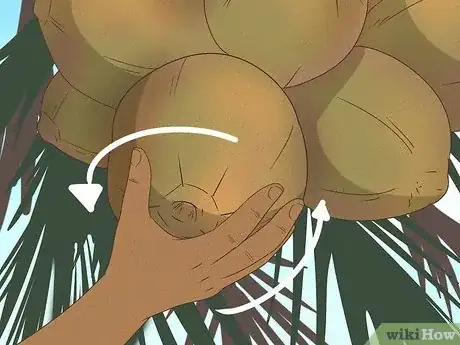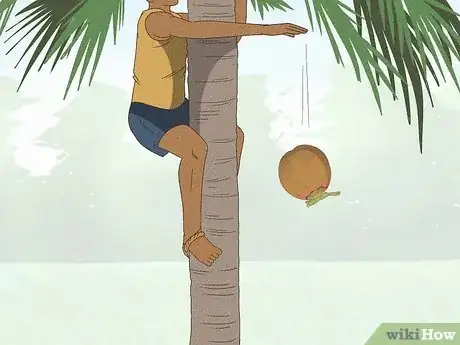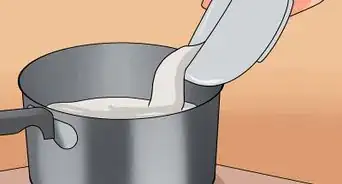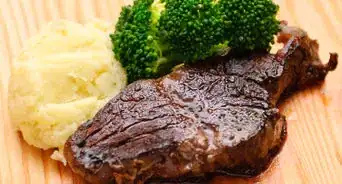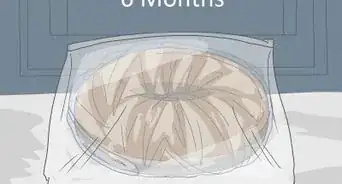This article was co-authored by wikiHow Staff. Our trained team of editors and researchers validate articles for accuracy and comprehensiveness. wikiHow's Content Management Team carefully monitors the work from our editorial staff to ensure that each article is backed by trusted research and meets our high quality standards.
There are 10 references cited in this article, which can be found at the bottom of the page.
This article has been viewed 30,095 times.
Learn more...
Coconuts don’t come any fresher than when they’re picked right off the tree. Gathering mature coconuts doesn’t require any special tools or know-how—once they get ripe enough, they’ll drop off the tree on their own. To harvest young coconuts, you’ll need to either use a long pole with an attached blade to dislodge the fruit from the high branches where they grow or strap on a climbing harness and remove them by hand.
Steps
Identifying Ripe Coconuts
-
1Select coconuts with a diameter of about 6–8 inches (15–20 cm). Naturally, young coconuts are smaller than older ones since they haven’t yet finished growing. In fact, a mature coconut can often be as much as 25-50% bigger than one that’s not ready to come down yet. By the time a coconut is ripe, it will have grown to an average of 12–18 inches (30–46 cm) in length and 6–8 inches (15–20 cm) in diameter.[1]
- Coconuts can vary in size, depending on the tree. For this reason, it’s usually best to go by color or texture when deciding whether a coconut is ready to harvest.
- Coconuts growing in bunches all tend to develop and ripen at the same rate.
-
2Squeeze the coconut to ensure that it's firm. The palm of a young coconut (the rubbery outer shell surrounding the brown, fibrous nut) should be dense and smooth with little give. Coconuts in the middle stages of development tend to soften a bit, and may display some light wrinkles or depressions. The once-smooth exterior will become wrinkled and woody as the fruit reaches maturity.[2]
- Until the coconut is ripe enough to drop on its own, it will need to be harvested manually.
Advertisement -
3Look for a golden brown color. Like other fruits, young coconuts start off with a pale green color. As the fruit ripens, it will begin to develop a golden yellow hue. Eventually, it will turn brown and any residual color will fade. The coconut will fall off the tree soon after reaching this point.
- Green coconuts (around 5-6 months old) have the highest water content, and are usually harvested for drinking purposes.
- When the coconut turns yellow (after 7-9 months), some of the water solidifies into “jelly,” or meat, which can be extracted and eaten or processed as a cooking ingredient.
- By the time a coconut turns brown (12-16 months old), most of the water inside will have been turned to milk. Mature coconuts are most often used to make creams and oils.
Cutting down Coconuts with a Harvesting Pole
-
1Make or buy a coconut harvesting pole. These tools are typically made by attaching a long, curved blade to the end of a bamboo shaft. A standard harvesting pole can be anywhere from 25–30 feet (7.6–9.1 m) long, which makes it possible to cut down coconuts from the safety of the ground.[3]
- Be on the lookout for a stalk of bamboo that's long enough to reach to the top of the tree where the coconuts are growing and big enough around to attach a harvesting scythe to the end.
- If you live in an area where coconut harvesting is a common practice, it may be possible to find special telescopic tools made from lightweight materials like carbon fiber or aluminum. They're also available online.
- Pole-picking is the method of choice in countries like India, Sri Lanka, Malaysia, and New Zealand.
-
2Maneuver the pole into position. Move a safe distance away from the base of the tree and stand the pole straight up on its end. Zero in on the coconut you want to cut and slowly and carefully guide the blade towards it. Try to hook the blade directly over the palm where it connects to the bunch.[4]
- Hold the harvesting pole tightly with both hands. Not only will this make it easier to control, it will also decrease your chances of losing your grip.
- Make sure there's no one else in the immediate vicinity that the pole could potentially injure if it happens to topple over.
-
3Cut the coconut free. Once you've got the blade hooked over the top of the palm, pull back on the pole with a forceful slashing action. The blades attached to harvesting poles are extremely sharp, so one or two hacks should be enough to bring it down.[5]
- Be patient. Since you’re working from an imprecise distance, it may take a few moments to successfully sever the coconut from the bunch.
-
4Watch for falling coconuts. Using a harvesting pole requires you to stand directly underneath the palms you’re collecting coconuts from, so be ready to duck out of the way if you see one plummeting towards you. The best way to do this is to move continuously around the tree in a zig-zag pattern as you work. It may look silly, but it beats getting conked on the head by a ripe coconut![6]
- According to some statistics, falling coconuts kill as many as 150 people per year worldwide.
Hand-Harvesting Coconuts Using a Climbing Device
-
1Strap on a palm climbing harness for an easy option. Step into the harness and cinch it tight around your waist and thighs. Run a length of climbing rope through the buckle on one side of the harness, then snake it around the base of the tree and clip it to the opposite side. Give the rope a tug to make sure it’s secure.
- Together, the rope and your feet will serve as a counterpoint to your weight, making it possible to ascend the tree in a slow and controlled manner.
- You can typically find climbing harnesses at outdoor recreation stores that sell rock climbing or rappelling equipment.
- Harnesses are most often used to climb trees that are 30–80 feet (9.1–24.4 m) or higher.[7]
-
2Fashion a makeshift foot strap if you don't have a climbing harness. To quickly improvise a foot strap, take a length of rope or strong fabric and tie the ends together so that it forms a loop. Twist the loop once in the center to make a figure-8 shape. Place a foot on each of the resulting stirrups and position yourself next to the base of the tree.[8]
- For best results, try to make sure your foot strap is no wider than the tree. Shorter straps are able to support more weight, which can allow you to “stand” on the trunk while you loosen the coconuts by hand.
- Double-knot the rope or cloth to make sure it will hold. Otherwise, it could give out on your halfway up the tree.
-
3Scale the tree until you’re high enough to reach the palms. If you're using a harness, walk your way up the trunk slowly, pulling the anchor rope up with you as you go. If you've made your own foot strap, push the center of the loop into the trunk to create traction and “hop” up little by little.[9]
- Take your time and be extremely careful. If necessary, pause every few seconds to rest before you continue.
- There’s no need to go all the way to the top—you just need to get within easy grabbing distance.
- Don’t reach too far to take hold of a coconut, as this may increase your risk of falling. If you find yourself stretching, you probably need to climb higher.
-
4Twist the coconut free by hand. Grip the palm by its smooth, round underside and rotate it in either a clockwise or counterclockwise direction. The action should feel similar to unscrewing a light bulb. After a few spins, it should come away with little effort.[10]
- If the coconut is being stubborn, you may need to pull on it gently to get it to come free.
- Avoid yanking or wrenching the coconut. Doing so could compromise your stability or cause you to lose your footing on the tree trunk.
-
5Drop the coconut point-first. Once you manage to detach the palm, turn it upside down (you should still be holding onto the rounded bottom at this point). Let it fall straight to the ground, then make your way back down cautiously.[11]
- Dropping it on the point rather than the bottom makes it less likely to crack open when it lands.
- It’s usually okay to drop mature coconuts from any angle, as they have tougher palms that are less prone to splitting.
Community Q&A
-
QuestionHow do I crack open a coconut?
 Community AnswerOne of the small circular "dents" in the top of the coconut can be pierced, so try all three. Drain the liquid. Cook the coconut for 10 minutes in a preheated 375°F oven, then take out and allow it to cool. Hit the coconut against a hard surface until you can separate the shell from the meat. Slice up the inner meat and enjoy.
Community AnswerOne of the small circular "dents" in the top of the coconut can be pierced, so try all three. Drain the liquid. Cook the coconut for 10 minutes in a preheated 375°F oven, then take out and allow it to cool. Hit the coconut against a hard surface until you can separate the shell from the meat. Slice up the inner meat and enjoy. -
QuestionWill a green coconut off the tree eventually turn brown, and about how long will it take?
 share goodnessCommunity AnswerIn general, early maturing coconut plants begin to produce fruit at the age of 3-4 years. For deep varieties, coconuts begin to produce fruit at the age of 6-8 years. Peak production at the age of 15-20 years. After the age of 20 years, production gradually declines and after the age of 40, production declines. Medium mature coconut/hybrid, peak production between the ages of 10-18 years.
share goodnessCommunity AnswerIn general, early maturing coconut plants begin to produce fruit at the age of 3-4 years. For deep varieties, coconuts begin to produce fruit at the age of 6-8 years. Peak production at the age of 15-20 years. After the age of 20 years, production gradually declines and after the age of 40, production declines. Medium mature coconut/hybrid, peak production between the ages of 10-18 years.
Warnings
- Avoid standing beneath a coconut palm unless you're preparing to climb. Plummeting coconuts can reach top speeds of around 53 miles per hour (85 km/h), which is fast enough to cause injury or even death.⧼thumbs_response⧽
- There’s an element of danger involved in harvesting fresh coconuts, no matter how you decide to do it. If you’re not confident in your climbing or pole-picking abilities, it may be best to just pick up a couple from the supermarket instead.⧼thumbs_response⧽
References
- ↑ https://www.producebluebook.com/wp-content/uploads/KYC/Coconut.pdf
- ↑ https://www.youtube.com/watch?v=X3BI5rK4qBE&feature=youtu.be&t=45
- ↑ https://www.producebluebook.com/wp-content/uploads/KYC/Coconut.pdf
- ↑ http://coconuthandbook.tetrapak.com/chapter/harvesting-and-post-harvest-management
- ↑ https://www.youtube.com/watch?v=PyT_mJVFXc0&feature=youtu.be&t=25
- ↑ http://travelwireasia.com/2016/01/do-falling-coconuts-really-kill-150-people-each-year/
- ↑ https://www.petzl.com/fondation/projets/grimper-securite-palmiers?language=en
- ↑ https://www.nytimes.com/2017/12/01/magazine/how-to-climb-a-coconut-tree.html
- ↑ https://www.youtube.com/watch?v=QSi_Aei1cAs&feature=youtu.be&t=112
